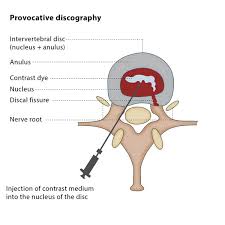 Provocative discography is an invasive diagnostic procedure for evaluation for intervertebral disc pathology.
Provocative discography is an invasive diagnostic procedure for evaluation for intervertebral disc pathology.
It is usually reserved for persons with persistent, severe low back pain (LBP) who have abnormal spaces between vertebrae on magnetic resonance imaging (MRI), where other diagnostic tests have failed to reveal clear confirmation of a suspected disc as the source of pain, and surgical intervention is being considered.
Spinal MRI is the imaging of choice to investigate the spine and intervertebral discs.
Lumbar discography is used to demonstrate degeneration and herniation of lumbar intervertebral discs by injecting a dye into the nucleus pulposus of the discs.
It is used to reproduce pain back pain for those who has such symptoms.
Lumbar discography is also used to access the response of a subject to anaesthetic injection.
It is useful to evaluate suspected discogenic pain without radicular signs and to confirm normal intervertebral discs above and below a site before spinal fusion: vidence supporting the usefulness of lumbar discography in recognising intervertebral disc problems are limited.
There is no role for cervical or thoracic discography in diagnosing disc pathologies at the cervical or thoracic regions.
In patients with local or distant infection, lumbar discography can add to the risk of infective discitis.
Non-ionic contrast media such as iopamidol and iohexol are used.
Needles are inserted through the back into the disc near the suspect area, guided by fluoroscopic imaging.
Fluid is then injected to pressurize the disc, and any pain responses are recorded.
A contrast agent is introduced, and after the procedure, a CT scan identifies leakage from the discs to identify any spinal disc herniation.
Possible complications include nerve damage, discitis, an infection of the disc.
Antibiotics are usually administered as a precaution.
